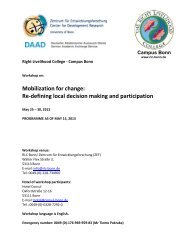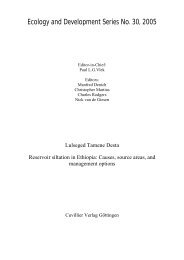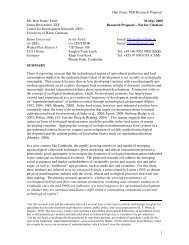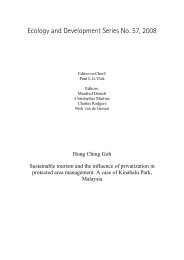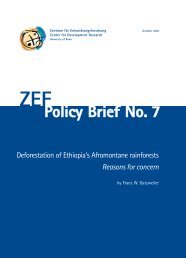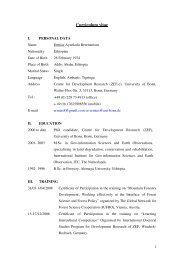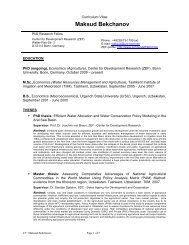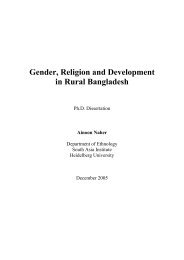ZEF Bonn
ZEF Bonn
ZEF Bonn
You also want an ePaper? Increase the reach of your titles
YUMPU automatically turns print PDFs into web optimized ePapers that Google loves.
1.5 Global trends in losses of tangible assets due to<br />
natural disasters<br />
Contrary to the trend in loss of human life, a significant increase in economic<br />
damages caused by natural disasters can be observed in recent decades. However,<br />
the property damages experienced, rising in absolute terms and expressed in monetary<br />
units, may reflect a real growth of damages, or a rising living standard with<br />
mounting property values, or an inflation-induced increase. To take this into<br />
account, the Munich Re (Münchener Rück - a German-based reinsurance company)<br />
has calculated both the inflation-induced increase and the increase in property<br />
values owing to rising standards of living since the early 1970s. It chose the gross<br />
domestic product (GDP) to roughly approximate the changed standard of living. The<br />
Munich Re concludes that regarding the increase of losses triggered by major natural<br />
events, inflation and a general accretion of value during the years 1970 to 1998<br />
play an important role. But the insurance company goes on to reason that damages<br />
are clearly on the rise in real terms. According to the Munich Re, GDP-adjusted economic<br />
damage amounted to US$ 315 billion in 1970-79, US$ 283 billion in<br />
1980-1989 and US$ 636 billion in 1990-1999. The damage figures provide clear<br />
evidence of an increase in the 1990s compared to the 1980s. According to the<br />
Munich Re (1998, 2000a, 2000b), the economic losses are distributed relatively<br />
evenly: storms, floods and earthquakes each make up 30 % of the recorded losses,<br />
while other hazards account for the remaining 10 %.<br />
We thus perceive two contrasting trends: a decrease in loss of human life over the<br />
past century and increasing economic damages, at least during the last decade. As a<br />
working hypothesis to account for this picture we assume that the coping capacity<br />
to deal with natural disasters has increased. It is difficult to determine how much<br />
this is thanks to international organisations and how much credit should go to<br />
national and local ones. In political, organisational and logistical terms, international<br />
relief agencies at inter-governmental, governmental, and NGO level have certainly<br />
learnt enormously in terms of how to react to major disasters. Compared to 50 years<br />
ago, they nowadays dispose of much higher capacities and resources for interventions<br />
in ongoing disasters.<br />
Effects of a volcano<br />
eruption, Pinatubo,<br />
Philippines<br />
Essay<br />
As far as natural disasters are<br />
concerned, two contrasting<br />
trends have been observed.<br />
While there was a decrease in<br />
loss of human life over the last<br />
century, economic damage has<br />
been on the increase over the<br />
last decade.<br />
13



